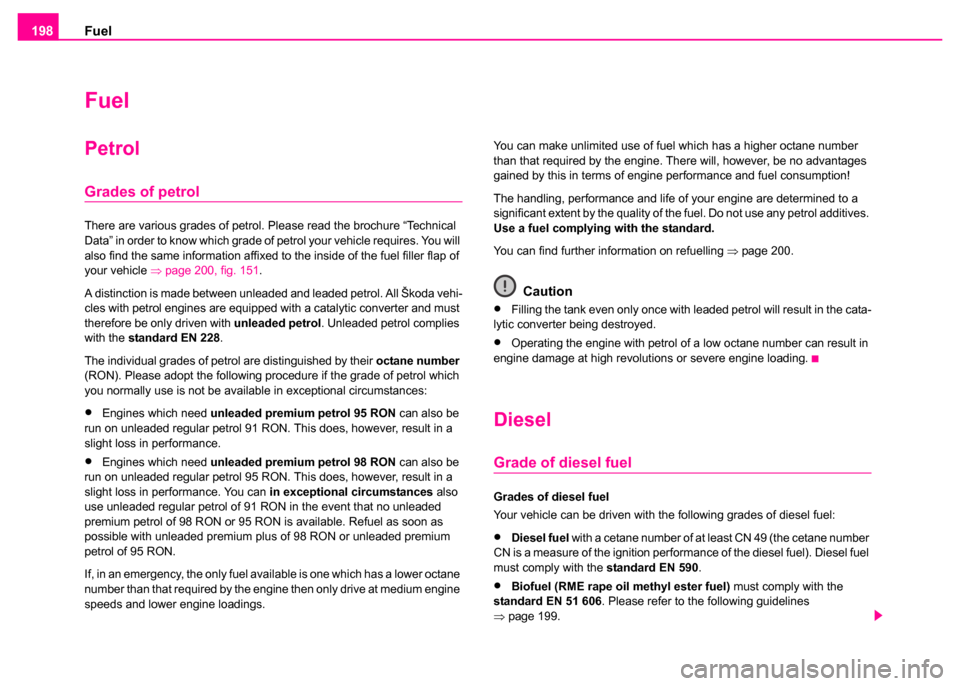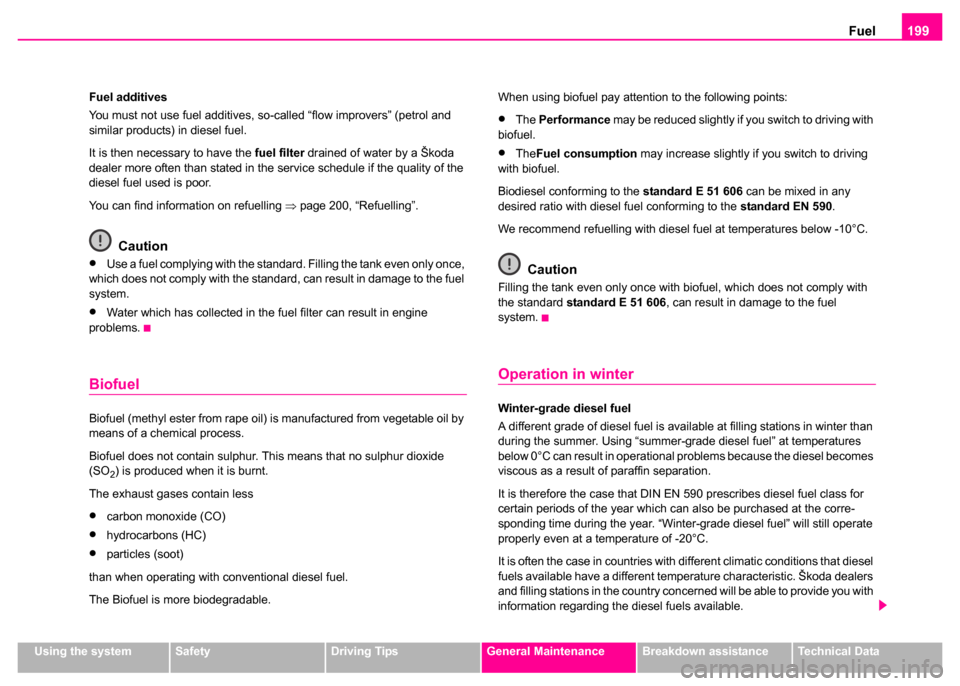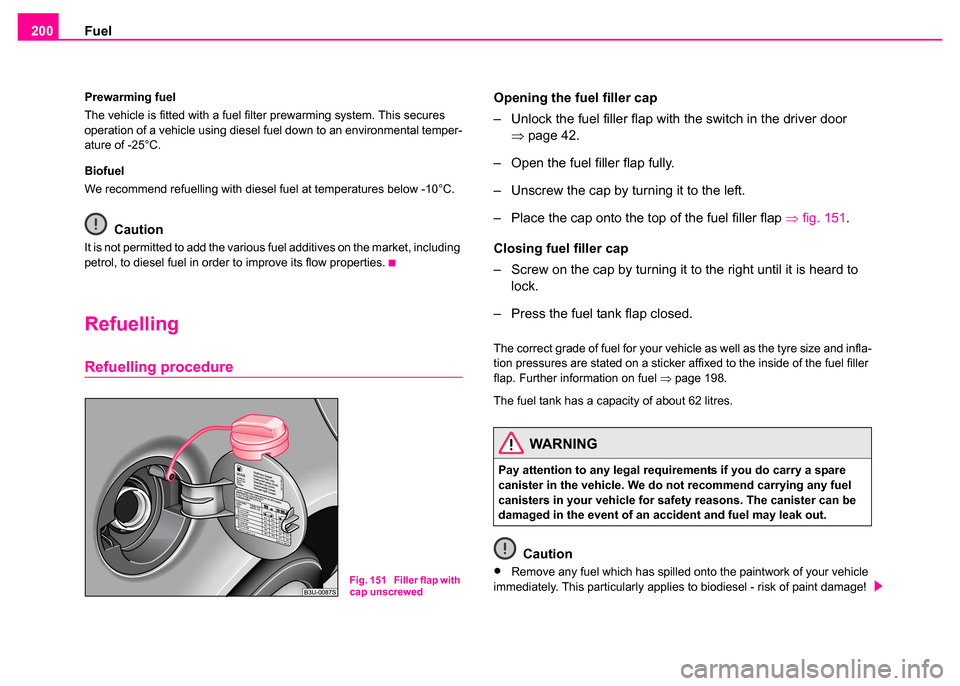fuel additives SKODA SUPERB 2003 1.G / (B5/3U) Owner's Manual
[x] Cancel search | Manufacturer: SKODA, Model Year: 2003, Model line: SUPERB, Model: SKODA SUPERB 2003 1.G / (B5/3U)Pages: 259
Page 199 of 259

Fuel
198
Fuel
Petrol
Grades of petrol
There are various grades of petrol. Please read the brochure “Technical
Data” in order to know which grade of petrol your vehicle requires. You will
also find the same information affixed to the inside of the fuel filler flap of
your vehicle ⇒page 200, fig. 151 .
A distinction is made between unleaded and leaded petrol. All Škoda vehi-
cles with petrol engines are equipped with a catalytic converter and must
therefore be only driven with unleaded petrol. Unleaded petrol complies
with the standard EN 228 .
The individual grades of petrol are distinguished by their octane number
(RON). Please adopt the following procedure if the grade of petrol which
you normally use is not be available in exceptional circumstances:
•Engines which need unleaded premium petrol 95 RON can also be
run on unleaded regular petrol 91 RON. This does, however, result in a
slight loss in performance.
•Engines which need unleaded premium petrol 98 RON can also be
run on unleaded regular petrol 95 RON. This does, however, result in a
slight loss in performance. You can in exceptional circumstances also
use unleaded regular petrol of 91 RON in the event that no unleaded
premium petrol of 98 RON or 95 RON is available. Refuel as soon as
possible with unleaded premium plus of 98 RON or unleaded premium
petrol of 95 RON.
If, in an emergency, the only fuel available is one which has a lower octane
number than that required by the engine then only drive at medium engine
speeds and lower engine loadings. You can make unlimited use of fuel which has a higher octane number
than that required by the engine. There will, however, be no advantages
gained by this in terms of engine performance and fuel consumption!
The handling, performance and life of your engine are determined to a
significant extent by the quality of the fuel. Do not use any petrol additives.
Use a fuel complying with the standard.
You can find further information on refuelling
⇒page 200.
Caution
•Filling the tank even only once with leaded petrol will result in the cata-
lytic converter being destroyed.
•Operating the engine with petrol of a low octane number can result in
engine damage at high revolutions or severe engine loading.
Diesel
Grade of diesel fuel
Grades of diesel fuel
Your vehicle can be driven with the following grades of diesel fuel:
•Diesel fuel with a cetane number of at least CN 49 (the cetane number
CN is a measure of the ignition performance of the diesel fuel). Diesel fuel
must comply with the standard EN 590 .
•Biofuel (RME rape oil methyl ester fuel) must comply with the
standard EN 51 606 . Please refer to the following guidelines
⇒ page 199.
Page 200 of 259

Fuel199
Using the systemSafetyDriving TipsGeneral MaintenanceBreakdown assistanceTechnical Data
Fuel additives
You must not use fuel additives, so-called “flow improvers” (petrol and
similar products) in diesel fuel.
It is then necessary to have the
fuel filter drained of water by a Škoda
dealer more often than stated in the service schedule if the quality of the
diesel fuel used is poor.
You can find information on refuelling ⇒page 200, “Refuelling”.
Caution
•Use a fuel complying with the standard. Filling the tank even only once,
which does not comply with the standard, can result in damage to the fuel
system.
•Water which has collected in the fuel filter can result in engine
problems.
Biofuel
Biofuel (methyl ester from rape oil) is manufactured from vegetable oil by
means of a chemical process.
Biofuel does not contain sulphur. This means that no sulphur dioxide
(SO
2) is produced when it is burnt.
The exhaust gases contain less
•carbon monoxide (CO)
•hydrocarbons (HC)
•particles (soot)
than when operating with conventional diesel fuel.
The Biofuel is more biodegradable. When using biofuel pay attention to the following points:
•The
Performance may be reduced slightly if you switch to driving with
biofuel.
•The Fuel consumption may increase slightly if you switch to driving
with biofuel.
Biodiesel conforming to the standard E 51 606 can be mixed in any
desired ratio with diesel fuel conforming to the standard EN 590.
We recommend refuelling with diesel fuel at temperatures below -10°C.
Caution
Filling the tank even only once with biofuel, which does not comply with
the standard standard E 51 606 , can result in damage to the fuel
system.
Operation in winter
Winter-grade diesel fuel
A different grade of diesel fuel is available at filling stations in winter than
during the summer. Using “summer-grade diesel fuel” at temperatures
below 0°C can result in operational problems because the diesel becomes
viscous as a result of paraffin separation.
It is therefore the case that DIN EN 590 prescribes diesel fuel class for
certain periods of the year which can also be purchased at the corre-
sponding time during the year. “Winter-grade diesel fuel” will still operate
properly even at a temperature of -20°C.
It is often the case in countries with different climatic conditions that diesel
fuels available have a different temperature characteristic. Škoda dealers
and filling stations in the country concerned will be able to provide you with
information regarding the diesel fuels available.
Page 201 of 259

Fuel
200
Prewarming fuel
The vehicle is fitted with a fuel filter prewarming system. This secures
operation of a vehicle using diesel fuel down to an environmental temper-
ature of -25°C.
Biofuel
We recommend refuelling with diesel fuel at temperatures below -10°C.
Caution
It is not permitted to add the various fuel additives on the market, including
petrol, to diesel fuel in order to improve its flow properties.
Refuelling
Refuelling procedure
Opening the fuel filler cap
– Unlock the fuel filler flap with the switch in the driver door
⇒page 42.
– Open the fuel filler flap fully.
– Unscrew the cap by turning it to the left.
– Place the cap onto the top of the fuel filler flap ⇒fig. 151.
Closing fuel filler cap
– Screw on the cap by turning it to the right until it is heard to lock.
– Press the fuel tank flap closed.
The correct grade of fuel for your vehicle as well as the tyre size and infla-
tion pressures are stated on a sticker affixed to the inside of the fuel filler
flap. Further information on fuel ⇒page 198.
The fuel tank has a capacity of about 62 litres.
Caution
•Remove any fuel which has spilled onto the paintwork of your vehicle
immediately. This particularly applies to biodiesel - risk of paint damage!Fig. 151 Filler flap with
cap unscrewed
WARNING
Pay attention to any legal requirements if you do carry a spare
canister in the vehicle. We do not recommend carrying any fuel
canisters in your vehicle for safety reasons. The canister can be
damaged in the event of an accident and fuel may leak out.